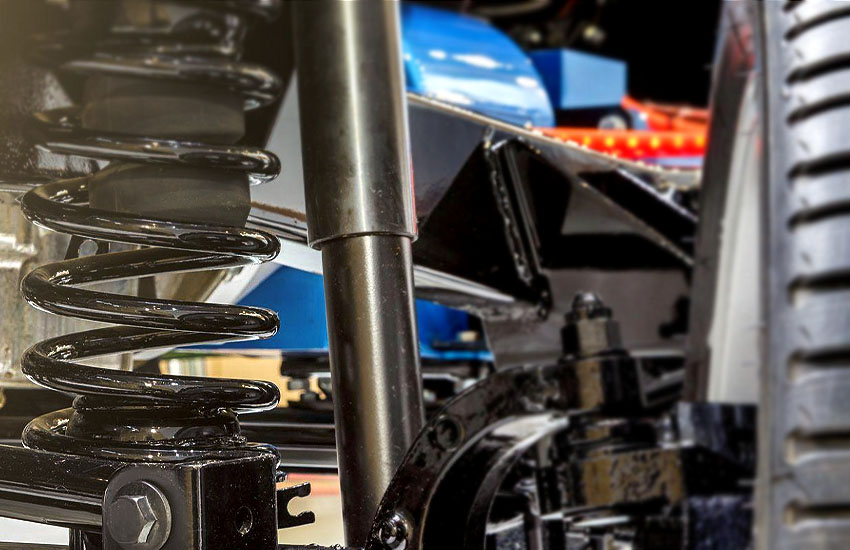Is your car making strange noises after installing new struts? You’re not alone! Strut noise is a common issue that many car owners face, especially after getting new struts installed. The sound could be anything from a squeak to a loud thud, and it can leave you wondering if something's wrong. In this article, we will dive into why new struts might be making noise and, more importantly, what you can do to fix it. Read on to uncover the mystery behind those annoying strut sounds!

What Are Struts and Why Do They Matter?
Before we dive into the noise issues, it's essential to understand what struts are and why they're so important for your car. Struts are a crucial part of your vehicle’s suspension system. They absorb shocks, stabilize the car’s movements, and support the weight of the vehicle. Essentially, they ensure a smooth and comfortable ride by reducing vibrations and keeping your wheels in contact with the road.
Struts combine both the shock absorber and a coil spring into one unit, making them different from traditional shocks. They help to maintain proper alignment, steering, and handling of the car. So when new struts start making noise, it can significantly affect the comfort and safety of your ride.
The Common Causes of Strut Noise After Installation
When you install new struts, it can be frustrating to hear noises that weren't there before. These sounds could range from squeaks, clunks, rattles, or even a harsh thud. The causes of these noises may vary, and identifying the issue will help you find the best solution. Here are some of the most common reasons why new struts may make noise:
- Improper Installation: Sometimes, the noise could be due to an error during the installation process. If the struts aren't mounted properly or the bolts aren't tightened to the correct specifications, you might hear unwanted sounds.
- Incorrectly Lubricated Parts: Struts have several moving parts that need proper lubrication to function smoothly. If the components of the struts, such as the top mount or bushings, aren't adequately lubricated, you might hear squeaks or friction-related noises.
- Defective Struts or Poor Quality Parts: In some cases, the noise may stem from the struts themselves. If the struts you installed are defective or poorly manufactured, they could cause noise despite being new.
- Worn-Out or Damaged Mounting Components: The mounting components that hold the struts in place, such as strut mounts, bushings, or bearings, can wear out over time. If these parts are damaged or installed incorrectly, they may create noise when the struts move.
- Improperly Adjusted Ride Height: If the ride height of your vehicle is altered after installing the new struts, this can cause noise due to changes in the suspension geometry. For example, if the ride height is too high or too low, it can place extra strain on certain suspension components, causing them to make noise.
- Insufficient Break-in Time: New struts need time to break in. During the first few drives, they might make some noises until all the components settle into place. This is often a temporary issue that fades over time.
Understanding these possible causes will help you determine the source of the noise and guide you toward the right solution.
Diagnosing Strut Noise: Step-by-Step
Now that we have a basic understanding of why new struts might make noise, it's time to figure out how to diagnose the issue. Diagnosing strut noise requires a systematic approach to identify the exact cause. Here's a step-by-step guide to help you pinpoint the problem:
Step 1: Listen to the Sound
The first step in diagnosing strut noise is to pay close attention to the type of sound your vehicle is making. Is it a squeak, a clunk, or a thud? The sound type can provide clues about what's causing the issue.
- Squeaks or Creaks: If you hear a squeaking sound when turning the steering wheel or going over bumps, it could be due to dry bushings or top mounts that haven't been lubricated properly.
- Clunking or Knocking: A loud clunk or knocking noise may indicate a loose or improperly installed strut, or a worn-out strut mount or bearing.
- Thudding or Rattling: A deep thud or rattle when driving over rough roads could suggest that the strut assembly is not correctly aligned or has a defective internal component.
Step 2: Inspect the Struts and Components
Once you've identified the sound, it’s time to visually inspect the struts and surrounding components. Look for signs of wear, damage, or improper installation. Here are a few things to check:
- Check the Strut Mounts: Strut mounts are the components that connect the strut to the vehicle's chassis. If the mounts are worn out or not installed correctly, they can cause noise. Look for any signs of cracks, wear, or damage to the mounts.
- Examine the Coil Springs: The coil spring that works in conjunction with the strut can sometimes become damaged or misaligned. Check to ensure that the coil spring is seated correctly and is not cracked or broken.
- Inspect for Leaks: If you notice oil or grease around the strut or its components, it could indicate a leak. A leaking strut may cause noise and can reduce the effectiveness of the suspension system.
- Check the Top Mount and Bearing: The top mount and bearing allow the strut to pivot as the wheel moves. If these parts are damaged or improperly installed, they can lead to noise.
Step 3: Test Drive the Vehicle
After performing a visual inspection, take the car for a test drive. While driving, pay attention to when the noise occurs. Does it happen when you go over bumps? Is it more noticeable when turning the wheel? Testing the vehicle can help you pinpoint whether the issue is related to the struts or other suspension components.
Step 4: Tighten the Bolts and Check for Loose Parts
Loose bolts or parts can often be the root cause of strut noise. If you notice any loose components during your inspection, tighten them to the proper specifications. It's crucial to ensure that all mounting bolts and nuts are secure. If any bolts were missed during installation, they could cause rattling or knocking noises.
Step 5: Consider the Quality of the Parts
If you've ruled out installation issues, it may be time to evaluate the quality of the struts themselves. Low-quality or defective struts can cause noise even if they are new. If the struts are from a lesser-known manufacturer or were cheaply made, they might not be up to standard. In such cases, replacing them with high-quality struts might be the best solution.
How to Fix the Noise: Solutions and Tips
Once you've diagnosed the cause of the strut noise, it's time to consider how to fix it. Depending on the problem, there are several solutions you can try. Here are some steps to help you get rid of that annoying noise once and for all:
1. Lubricate the Strut Mounts and Bushings
If the noise is caused by friction between moving parts, lubrication can often solve the problem. Use a silicone-based lubricant or a similar high-quality product to lubricate the strut mounts, bushings, and other suspension components that may be squeaking. This will reduce friction and prevent the parts from rubbing together, eliminating the noise.
2. Tighten or Replace Strut Mounts
If the strut mounts are loose or damaged, tightening or replacing them could resolve the issue. Strut mounts are relatively easy to replace, and doing so can prevent further damage to other suspension components. If you’re unsure about how to replace the mounts, it’s best to consult a mechanic or refer to your car's manual for instructions.
3. Ensure Proper Installation
If the noise occurred shortly after installation, there's a chance that the struts were not installed correctly. If you suspect poor installation, it may be worth having a professional mechanic recheck the installation to ensure everything is in its proper place.
4. Replace Defective or Low-Quality Struts
If the struts themselves are of poor quality or defective, the only permanent solution may be to replace them with higher-quality units. Investing in a well-known brand with good reviews can help prevent future issues and reduce the chances of noise.
5. Adjust Ride Height
If the ride height of your vehicle was altered after the struts were installed, adjusting the suspension to its proper height could eliminate any extra strain on the struts and suspension components. Check the manufacturer's recommendations for the ideal ride height and adjust accordingly.
Strut noise can be annoying, but with the right knowledge and steps, it's possible to diagnose and fix the issue. Whether it's improper installation, worn-out components, or defective struts, addressing the cause will help you restore your vehicle’s comfort and performance. Don’t forget to consult a professional mechanic if you’re unsure about any repairs.
Frequently Asked Questions
Is it normal for new struts to make noise?
New struts may make some noise during the break-in period, but consistent noise after installation could indicate an underlying issue, such as improper installation or defective parts.
Can I drive my car if the struts are making noise?
It depends on the cause of the noise. If the noise is from a minor issue, such as lubrication, it might be safe to drive. However, if the noise is from damaged or loose components, it's best to get the struts checked immediately.
Do I need to replace the struts if they're making noise?
Not necessarily. If the noise is due to improper installation, lubrication issues, or worn-out mounts, repairing or replacing specific components might be enough. Only replace the struts if they're defective.
Can improper installation cause strut noise?
Yes, improper installation is one of the most common causes of strut noise. If the struts are not mounted or aligned correctly, they can create a variety of sounds, such as clunks or squeaks.
Is it safe to drive with noisy struts?
If the noise is mild and doesn't affect the car's handling or safety, it may be safe to drive. However, if the noise is severe or the handling is compromised, it's best to have the struts inspected and repaired.
Can worn-out strut mounts cause noise?
Yes, worn-out or damaged strut mounts can cause a variety of noises, including clunks or squeaks. Replacing the mounts can help reduce or eliminate the noise.
Do struts need lubrication?
Yes, strut mounts and bushings need to be lubricated to prevent squeaking and other noise. Lack of lubrication can cause friction, leading to irritating sounds while driving.
Can I fix noisy struts myself?
If you’re familiar with suspension systems and have the proper tools, you can attempt to fix noisy struts yourself. However, if you’re not confident, it’s recommended to consult a professional mechanic to ensure proper repair.


